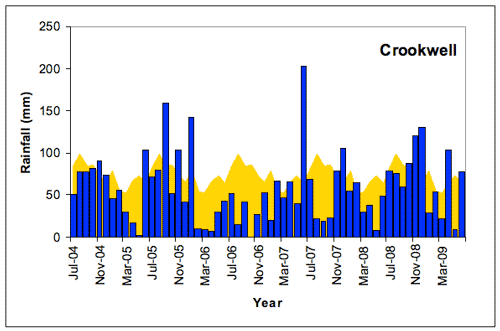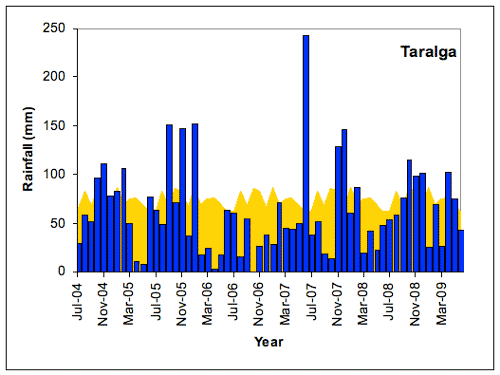Upper Lachlan
Please note: Text or data highlighted in this colour represent an update to this indicator for the period 2008/09. All rainfall figures have been updated on this page.
Rainfall Analysis
The main rainfall observing sites used in this analysis were Taralga (Bureau of Meteorology Station No. 070080), which has records commencing in 1882, and Crookwell Post Office (No. 070025) which commenced in 1883. Data from nearby stations were used to calculate values for months with missing data at this site (see Appendix 2 for further information).
Note that in the following analyses rainfall totals for individual months or years (where the year is defined as the 12 months from July to June) are compared to the long-term average (or climatology) from 1961-1990. A 30-year period is used to calculate climatological averages to conform with World Meteorological Organisation practice; this takes into account year-to-year variations and less frequent events such as El Niño or La Niña. This particular 30-year period is used internationally as a standard climatological average period.
As shown in the table below, Crookwell and Taralga were both drier than average in all five years in the period 2004/05-2008/09. The driest year at both places was 2007/08, when rainfall was 36.1% below the long-term average at Crookwell, and 23.7% below average at Taralga. This year was the fifth driest Jul-Jun 12 month period since records began at Crookwell. The wettest year for both sites in the last four years was 2008/09. However rainfall at Crookwell was still 3.78% below average and 4.3% below average at Taralga in this period.
| Rainfall Statistics | Crookwell | Taralga | ||||||||
|---|---|---|---|---|---|---|---|---|---|---|
2004/5 |
2005/6 |
2006/7 |
2007/8 |
2008/9 |
2004/5 |
2005/6 |
2006/7 |
2007/8 |
2008/9 |
|
| Annual Total* (mm) | 707.8 |
751.5 |
632.2 |
563.5 |
849.6 |
760.9 |
796.2 |
675.3 |
673.2 |
844.7 |
| Anomaly (mm) | -174.0 |
-130.3 |
-249.6 |
-318.3 |
-32.2 |
-122.0 |
-86.7 |
-207.6 |
-209.7 |
-38.2 |
| Anomaly (%) | -19.7 |
-14.8 |
-28.3 |
-36.1 |
-3.7 |
-13.8 |
-9.8 |
-23.5 |
-23.7 |
-4.3 |
| Mean (1961-1990) (mm) | 881.8 |
882.9 |
||||||||
*Note: annual totals were calculated for the 12 months July-June.
Monthly Rainfall, 2004-2009
A comparison of monthly rainfall totals with the long-term monthly average rainfall at Crookwell and at Taralga (Figure 1a and b) shows that there were very similar trends between the two sites with below average rainfall for most of the period and only short periods of average or above average rainfall. The longest dry period occurred during 2006/7 while autumns of 2005 and 2008 were also dry. The wettest periods occurred in 2005 and the latter part of 2007 and 2008. June 2007 was the wettest month at Taralga and most likely at Crookwell while October 2006 was the driest month at both locations. The prolonged period of below-average rainfall in 2006-2007 was associated with an El Niño event while the rainfall at the end of 2007 was due to a La Niña event as was the wet period November 2008-January 2009.
a b |
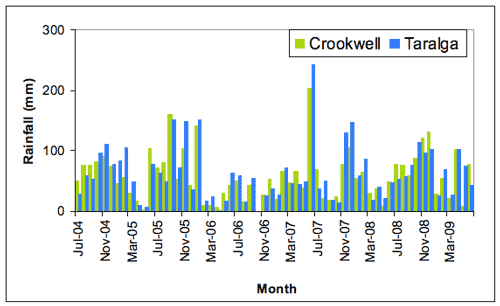 |
Of the 60 months in this period, 39 (65% of the record) had below-average rainfall at Taralga, and 42 (70%) at Crookwell (Figure 3). The most prolonged dry spell in the region began in February 2006 and extended to May 2007. June 2007 was extremely wet then very dry conditions returned for the period July to October 2007. Dry conditions were also experienced at both locations for the autumns of 2005 and 2008. The driest individual month at both Crookwell and Taralga was October 2006 with 0.4 mm being recorded at both locations (long-term average 85.6 mm at Crookwell and 85.2 mm at Taralga). Conditions were significantly wetter than normal only during May 2005 to January 2006, June 2007, November 2007 to December 2007 and October to December 2008. The wettest month for the period at Taralga was June 2007 with 242.8 mm (long term average for June is 62.3 mm). This was also most likely the wettest month at Crookwell as well. June 2007 was the third wettest June on record for Taralga since 1883.
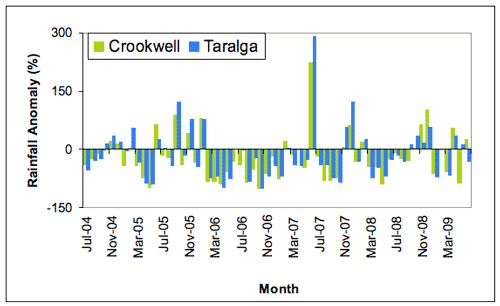 |
The results of the generally dry conditions across the region can be seen in Figure 4. Both Crookwell and Taralga show similar trends with rainfall accumulations. After only being just below the norm for 2005 and 2005, both then showed a rapid increase in the deficit during 2006 and 2007. The deficit continued to flatten out during 2008/9 at both Crookwell and Taralga. This reflected the dry conditions associated with the El Niño event experienced in 2006/7. The total accumulated deficits were 888.6 mm at Crookwell (101% of the Crookwell Jul-Jun annual rainfall) and 663.3 mm at Taralga (75% of the Taralga Jul-Jun annual rainfall).
a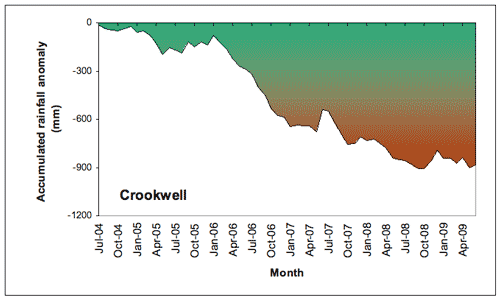 b b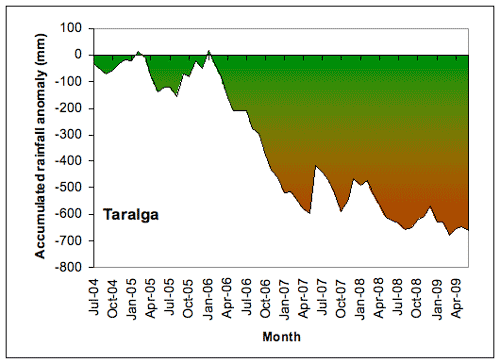 |
The climatological context for rainfall at Crookwell and Taralga
The long-term perspective
As is typical of the region, Crookwell and Taralga have experienced large fluctuations in annual (July-June) rainfall, including several extended periods of above- and below-average rainfall since records began in 1884/85. In general, and particularly at Taralga, annual rainfall was lower and less variable early in the 20th century, followed by a period of greater variability. Rainfall variability has been lower since about 1980 (Figures 5 and 6). The dry period evident in the last part of the records at both Crookwell and Taralga is reflected in other parts of the record such as the late 1890’s to the early 20th century and the 1937-45 period and therefore must be considered as lying within natural variability.
- Rainfall at Crookwell in the late 19th and early 20th century was generally below average (to about 1920), after which conditions became wetter until the mid-1930s.
- Following drier than average conditions that dominated the record until 1950, there were several wet spells (primarily in the 1950s and 1970s).
- A generally drier period around 1980 was followed by several wetter years. Since 2000 conditions have been drier than average.
The wettest year (July-June) on record at Crookwell was 1951/2 (1354 mm); the driest year was 1885/6 (497 mm).
- At Taralga rainfall was generally below average until about 1950, when the annual rainfall totals became more variable.
- Several wetter-than-normal years around 1950 and 1960 produced a generally wetter period then; the same is true of the mid 1970s.
- A consistently drier period around 1980 was followed by slightly above-average rainfall until the early 1990s. Since 1992 conditions have been generally drier than average particularly since 2000.
The wettest year (July-June) on record at Taralga was 1949/50 (1458 mm); the driest year was 1885/6 (383 mm).
![Figure 5. Annual (July-June) rainfall at Crookwell from 1884/5 to 2008/9 depicted as deviations from the long-term mean. A 5-year running mean is superimposed to highlight wetter and drier periods. [Deviations were calculated as the difference between the rainfall for each year and the mean for the period 1961-1990 (scale in mm).]](../images/upperlachlan/rain07.gif) |
![Figure 6. Annual (July-June) rainfall at Taralga from 1885/6 to 2008/9 depicted as deviations from the long-term mean. A 5-year running mean is superimposed to highlight wetter and drier periods. [Deviations were calculated as the difference between the rainfall for each year and the mean for the period 1961-1990 (scale in mm).]](../images/upperlachlan/rain08.gif) |
The extent of the dry period that commenced in 2002 is similar at Crookwell and Taralga (Figure 7). Rainfall at both stations reflect the fact that there were two successive El Nino events (2002/3 and 2006/7) without a compensating wet period between them. There were 78 months (72%) of rainfall deficits at Crookwell and 79 months at Taralga (73%). Overall the total rainfall deficit at Crookwell was 1771.4 mm (201% of the Crookwell Jul-Jun annual rainfall) and 1761.4 mm at Taralga (200% of the Taralga Jul-Jun annual rainfall).
a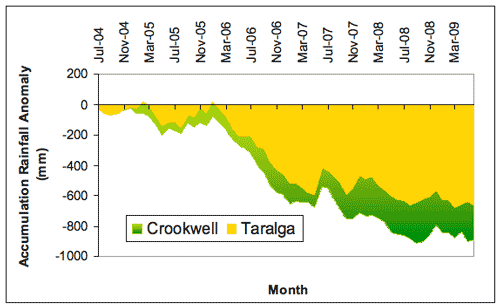 b b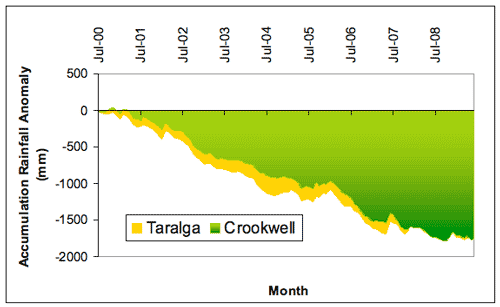 |
About the data
